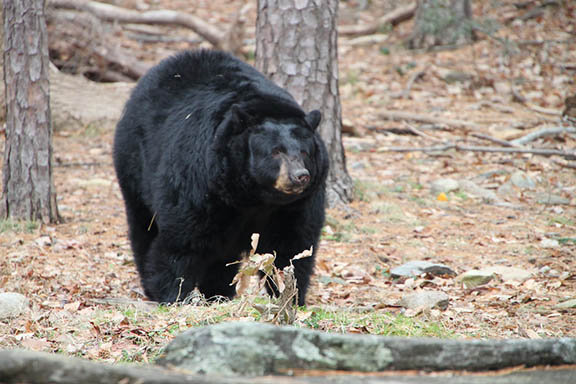Last updated on April 14th, 2021 at 05:15 pm
If you’re anything like me, before a backpacking excursion you develop a number of hypothetical scenarios that result in bears eating you alive. Since I am a woman, some of these scenarios stem from a largely unanswered question: Do periods attract bears?
In this post, we look into whether bears are attracted to period blood, what type of research has been done to answer this question, and whether our menstruating readers really need to worry that they’ll become a meal.
Are Bears Attracted to Period Blood
While there aren’t many studies published on this subject (surprise), there have been a few we can reference to shed light on how different bear species perceive menstrual blood and women on their periods.
In short, Black Bears and Grizzly Bears have displayed they are not attracted to menstrual blood or women on their periods. Polar Bears, on the other hand, do seem to show interest in menstrual blood, used tampons, and women on their periods.
Yes, the statement above is a bit of a blanket statement. I would highly recommend reading through the rest of this post to learn how the studies referenced come to the conclusions above. Below we go through each bear species, the study that was completed, and what the study found.
1. Black Bears and Menstrual Blood
In a study conducted by the U.S. Forest Service by Rogers et al., Reactions of Black Bears to Human Menstrual Odors (1991), used tampons were literally drug across the noses of Black Bears.

More specifically, used tampons from 15 women were bundled in packs of 5, and then presented to groups of black bears feeding on garbage. The black bears were offered the used tampons 15 times! This gave the black bears a choice of feeding on garbage or feeding on tampons. Every single time, the black bear opted for the garbage!
READ ALSO: 9 Tips for Backpacking and Camping During Your Period
What the above proved, in a sense, was that black bears would opt for a meal over menstrual blood. Moreso than that, they do not seem to associate menstrual blood with a meal.
That is good news for me (and you)!
More on The Rogers et. al. Black Bear Study
If you are concerned that the black bears weren’t offered the used tampons directly enough in the 1991 study, rest assured. The study only considered the “offer” of used tampons successful if:
-
- The black bear sniffed the used tampons directly OR
- If the used tampons were less than 30 centimeters from the bear’s nose for a minimum of 15 seconds.
In addition to the direct offering of used tampons to black bears, the study also tested whether women using tampons and pads attracted black bears. Menstruating women were sat near black bears for a minimum time period and on various occasions.
All of the results support black bears not being interested in menstruating women or period blood.
In the words of the study:
No bear showed appreciable interest in menstrual odors regardless of the bear’s age, sex, reproductive status, or the time of year.
2. Grizzly Bears and Menstrual Blood
In a 1985 study completed by Stephen Herrero, Bear Attacks: Their Causes and Avoidance, hundreds of different grizzly bear attacks were analyzed. In combing through the records on hundreds of real word grizzly bear attacks, none could be linked to menstruating women or period blood.

Simply put, the Herrero study provided convincing evidence grizzly bears don’t attack people just because they’re on their periods.
I should point out again that the Stephen Herrero research did not include testing of individual Grizzly Bears. Instead, the study used analysis of existing bear attack data to determine there was no statistical connection between Grizzly Bear attacks and menstruating women.
3. Polar Bears and Menstrual Blood
Of the three bear species we cover in this post, polar bears are the only to exhibit a strong interest in menstrual blood.
In the 1983 University of Montana Study by Bruce S. Cushing, Responses of Polar Bears to Human Menstrual Odors, polar bears were shown to be drawn to period blood.

Aren’t convinced that polar bears are attracted to menstrual blood? Below we summarize the Cushing study to provide more information about how Cushing came to this conclusion.
More On The Cushing Polar Bear Study
Lab testing and field testing were both a part of the 1983 study.
Official Findings of The Polar Bear Lab Testing
For the lab work, five bears were captured in the wild and brought to a wildlife laboratory where they were presented with different scents. The scent of the bears’ most common food source, seals, were presented to the bears individually, as were used tampons, and women on their periods.
Polar Bears React To Menstrual Blood
While the bears remained inactive (sitting) for the majority of the time in captivity, the scent of a seal elicited a major response. Pacing the cage, sniffing toward the source of the scent, and biting the cage were all a part of the polar bears’ reaction to seal.
When presented with other scents, polar bears did not display any noteworthy reaction. The only exception to this was the scent of used tampons. As used tampons were presented to polar bears, they exhibited a reaction nearly as intense as when presented with the scent of a seal.
Related: What to do if a Mountain Lion is Stalking You – Lions in National Parks
In other words, polar bears were proving to be extremely interested in menstrual blood and exhibiting preditor behavior when smelling these scents.
Polar Bears React (albeit less) to Menstruating Women
As a part of the Cushing lab testing, each of the bears was presented with women on their periods. These women sat in the same room as the caged polar bear, and their scent was directed toward the bear with a fan.
The bears didn’t exhibit the maximum responses as displayed when presented with seal scent, but “moderate” responses were recorded including one instance where a bear pounced at the cage in the direction of the menstruating women.
Official Findings of Cushing’s Polar Bear Field Testing
For the fieldwork, 42 stakes were driven into the ground so approximately 40 cm remained above ground. A variety of scents were put on the stakes at varying times and the behavior of the bears observed.
For the menstrual blood portion of the testing, 5 ml of menstrual blood was put on paper towels, which were ultimately secured to the top of each one of the 42 stakes. Every time a bear was downwind from the stakes their behavior was recorded in detail.
The study found used tampons were a scent of significant interest to polar bears. The different scents tested showed used tampons ranked among the bears’ favorite food scents.
Luckily for me, I don’t typically go backpacking in the arctic!
Is It Safe to Hike on Your Period?
The answer is, yes.
It is absolutely safe to hike on your period. From the studies referenced in this post, it seems the only real concern regarding hiking on your period should be when hiking in polar bear habitat. Polar bears don’t populate a large geographic area so the risks are VERY minimal for almost anyone reading this post.
If you do plan on hiking or backpacking on your period there are best practices for doing so in the safest most environmentally friendly way possible. Outside of that, you should be good to go.
So, grab your favorite backpack, strap on your GPS watch, and head out onto the trails.
RELATED POSTS:
- 9 Tips for Backpacking and Camping During Your Period
- How to Break in Hiking Boots | Reduce Blisters and Hike Comfortably
- What to Wear on a Hiking Date | Guide for Men and Women
- 11 Tips for Hiking Muddy Trails | No Mud No Fun!
- Best Speed Hiking Shoes For Any Terrain
Post Sources:
Herrero, S.M. 1985. Bear attacks – their causes and avoidance. Winchester Press, New Century Publishers, Inc., Piscataway, New Jersey. 287pp.
Cushing, B. 1983. Responses of polar bears to human menstrual odors. International Conference on Bear Research and Management 5:270-274.
Gunther, K.A., and H.L. Hoekstra. 1996. Bear-inflicted human injuries in Yellowstone, 1970-1994, a cautionary and instructive guide to who gets hurt and why. Yellowstone Science 4(1): 2-9.
Byrd, C.P. 1988. Of bears and women: Investigating the hypothesis that menstruation attracts bears. M.S. Thesis, Univ. Montana, Missoula. 129pp.
Image Source: mackenzie and john (https://www.flickr.com/photos/mackenzieandjohn/) Attribution-ShareAlike 2.0 Generic (CC BY-SA 2.0)
Image Source: Michael Maher (https://www.flickr.com/photos/the4mahers/) Attribution-ShareAlike 2.0 Generic (CC BY-SA 2.0)
Image Source: Gregory “Slobirdr” Smith (https://www.flickr.com/photos/slobirdr/) Attribution-ShareAlike 2.0 Generic (CC BY-SA 2.0)
Image Source: Smudge 9000 (https://www.flickr.com/photos/smudge9000/) Attribution-ShareAlike 2.0 Generic (CC BY-SA 2.0)

